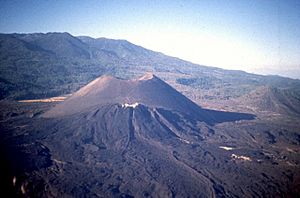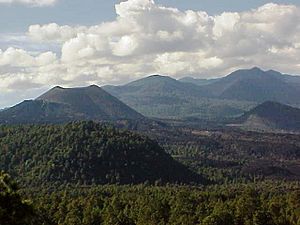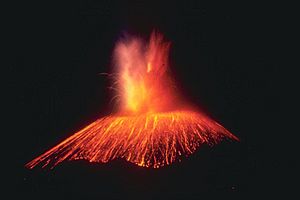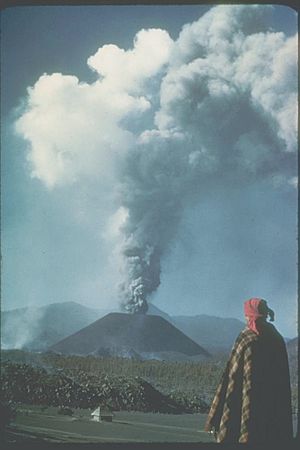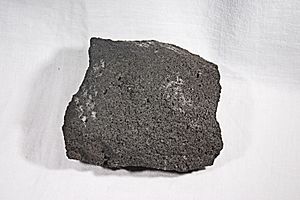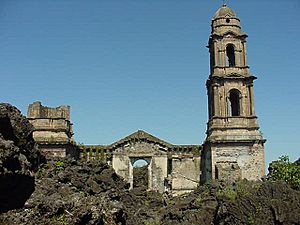Parícutin facts for kids
Quick facts for kids Parícutin |
|
|---|---|

Parícutin in 1994
|
|
| Highest point | |
| Elevation | 2,800 m (9,200 ft) |
| Prominence | 208 m (682 ft) |
| Geography | |
| Country | Mexico |
| State | Michoacán |
| Geology | |
| Age of rock | 1941–1952 |
| Mountain type | Cinder cone |
| Volcanic arc/belt | Trans-Mexican Volcanic Belt |
| Last eruption | 1943 to 1952 |
| Climbing | |
| First ascent | 1943 |
| Easiest route | Hike |
Parícutin is a famous cinder cone volcano in Mexico. It is located in the state of Michoacán, not far from the city of Uruapan. This volcano is special because it suddenly appeared in a farmer's cornfield in 1943!
Scientists watched Parícutin closely during its nine years of activity. It was the first time they could study a volcano like this from start to finish. By 1952, the eruption had created a cone 424-meter-high (1,391 ft). It also damaged a large area of over 233 square kilometers (90 sq mi) with volcanic ash and lava.
Sadly, three people died from lightning during the eruption. Two towns were completely covered by lava and had to be evacuated. Many people had to move and start new lives. Today, Parícutin is a quiet, or dormant, volcano. It has become a popular place for tourists to visit. People can even climb the volcano and see the old church ruins covered in hardened lava.
In 1997, CNN called Parícutin one of the Seven Natural Wonders of the World.
Contents
What is Parícutin?
Parícutin is found in the Mexican state of Michoacán. It is about 29 kilometers (18 mi) west of Uruapan. The volcano sits on the side of a larger, older volcano called Pico de Tancítaro. Parícutin itself rises 424 meters (1,391 ft) above the nearby valley.
This volcano is part of a huge chain of volcanoes called the Trans-Mexican Volcanic Belt. This belt stretches for 900 kilometers (560 mi) across central Mexico. It has thousands of small volcanoes, including many cinder cones like Parícutin. This volcanic activity has made the soil very fertile, which is great for farming.
Parícutin is the newest of about 1,400 volcanic spots in the Michoacán-Guanajuato volcanic field. Cinder cones are the most common type of volcano in Mexico. They usually appear quickly, build a cone shape, and then become quiet.
Is Parícutin still active?
Today, the crater of Parícutin is about 200 meters (660 ft) wide. You can climb the volcano and walk around its top. Scientists say Parícutin is now extinct, meaning it won't erupt again. However, it is still warm inside. Rainwater seeps in and turns into steam, so you can still see steam coming out.
The forces that created the volcano are still at work deep underground. In 1997, there were many earthquakes near Parícutin. This showed that magma was moving below. More earthquakes happened in 2006, but no new eruption occurred.
How Parícutin Formed
Parícutin erupted for nine years, from 1943 to 1952. This was a long time for this type of volcano. Before it erupted, people in the area heard strange thunder-like noises for weeks. But there were no clouds in the sky! This sound came from deep earthquakes caused by magma moving underground. Scientists later found that 21 earthquakes happened in the five weeks before the eruption. The day before the eruption, people felt about 300 earthquakes!
The eruption began on February 20, 1943, around 4:00 PM. It started in a cornfield owned by a farmer named Dionisio Pulido. He and his family were working in the field when the ground suddenly swelled up. A crack, about 2 to 2.5 meters wide, opened up. They heard hissing sounds and smelled rotten eggs, which meant hydrogen sulfide gas was present. Within hours, this crack became a small crater.
On that first day, the volcano began to shoot out hot rocks and ash. Within 24 hours, a cone 50 meters (160 ft) high had formed. This cone was made of small rock fragments and larger, semi-molten volcanic bombs. By the end of the first week, the cone was already between 100 meters (330 ft) and 150 meters (490 ft) tall. Soon, the whole valley was covered in smoke and ash.
Eruption Stages
The volcano's nine years of activity can be divided into four main stages. These stages have names from the local Purépecha language.
- The first stage, called Quitzocho, lasted from February to October 1943. During this time, the volcano mostly shot out small rocks and bombs. In just four months, the cone grew to 200 meters (660 ft). By eight months, it was 365 meters (1,198 ft) tall. Lava also started to flow. On June 12, lava began to move towards the village of Parícutin, forcing people to leave the next day.
- The second stage, Sapichi (meaning "child"), was from October 1943 to January 1944. A new opening formed on the side of the cone. This new vent sent lava towards the town of San Juan Parangaricutiro. This forced everyone to leave that town permanently. By August, the town was completely buried by lava and ash. Only the top of the main church could still be seen. Luckily, no one died during these evacuations because the lava moved slowly. These first two stages created most of the volcano's height and material. Ash even reached as far as Mexico City!
- The third stage, Taqué-Ahuan, lasted from January 1944 to January 1945. During this time, new cracks formed on the south side of the cone. Lava flows mostly went to the west and northwest.
- For the next seven years, the volcano became less active. It would shoot out ash, stone, and lava only sometimes, with quiet periods in between. The last big burst of activity happened in January and February 1952. Several eruptions happened, and a smoke column 3 kilometers (1.9 mi) high was produced.
Studying Parícutin
Parícutin was very important for scientists. It was the first time volcanologists could fully study a volcano's entire life. Geologists from all over the world came to see it. Two main researchers, William F. Foshag from the Smithsonian Institution and Dr. Jenaro Gonzalez Reyna from Mexico, stayed for years. They wrote detailed notes, drew maps, and took thousands of photos. Many of their studies are still used today.
Studying Parícutin helped scientists understand volcanoes much better. It especially helped them learn how cinder cone volcanoes form.
Life After the Eruption
Even during Second World War, the eruption caught worldwide attention. Reporters from magazines like Life came to cover the story. Later, airline pilots would point out the volcano to their passengers. Even Hollywood films, like Captain from Castile, used the erupting volcano as a backdrop. The eruption also inspired many Mexican artists.
The eruptions finally stopped in 1952. The volcano left behind a cone 424 meters (1,391 ft) tall. The eruption destroyed or heavily damaged an area of 233 square kilometers (90 sq mi). Almost all plants near the crater were gone. Lava covered 26 square kilometers (10 sq mi), and volcanic sand covered 52 square kilometers (20 sq mi).
The town of Parícutin, which had 733 people, is now completely gone. Of San Juan Parangaricutiro, with 1,895 people, only parts of its main church can still be seen sticking out of the hardened lava.
No one died directly from the lava or ash. However, three people were killed by lightning during the eruptions. The eruption mainly affected five towns. Two towns were destroyed, and three others were heavily damaged. Many people had to move permanently. Before leaving his home for the last time, farmer Dionisio Pulido put up a sign that said: "This volcano is owned and operated by Dionisio Pulido."
The people from the destroyed towns were moved to new places. The town of San Juan Parangaricutiro was the main town of its area. After it was destroyed, a new town was created, now called San Juan Nuevo.
The area's economy was mostly farming. The people were mainly from the Purépecha group. The eruption changed their lives. But the fame of the volcano also brought more visitors and contact with the outside world.
Today, Parícutin is a big tourist spot. The main way to visit is from the town of Angahuan. You can hire guides and horses there. You can visit the ruins of the San Juan Parangaricutiro Church, which is still a special place for pilgrims. People also climb the volcano itself. The volcano is part of the Pico de Tancítaro National Park. The climb is mostly on horseback, with the last part on foot. You need a guide because the path is not always clear.
The story of Parícutin's birth is told in the children's book Hill of Fire by Thomas P. Lewis.
See also
 In Spanish: Paricutín para niños
In Spanish: Paricutín para niños
- List of volcanoes in Mexico
- Shōwa-shinzan




